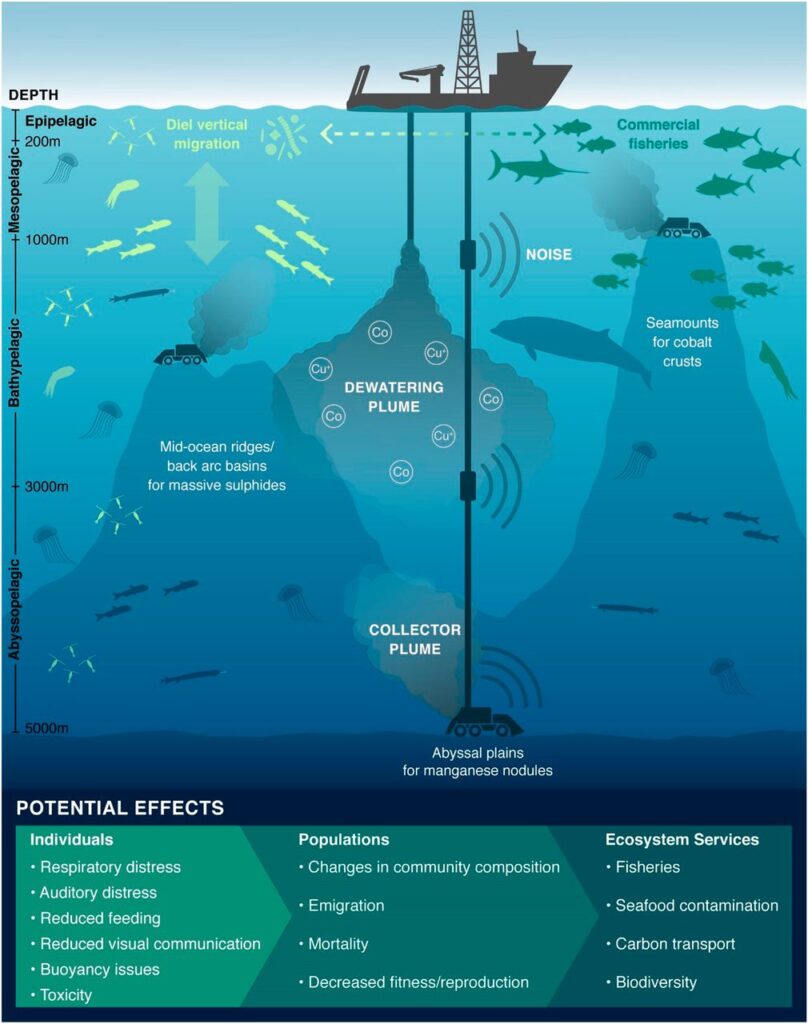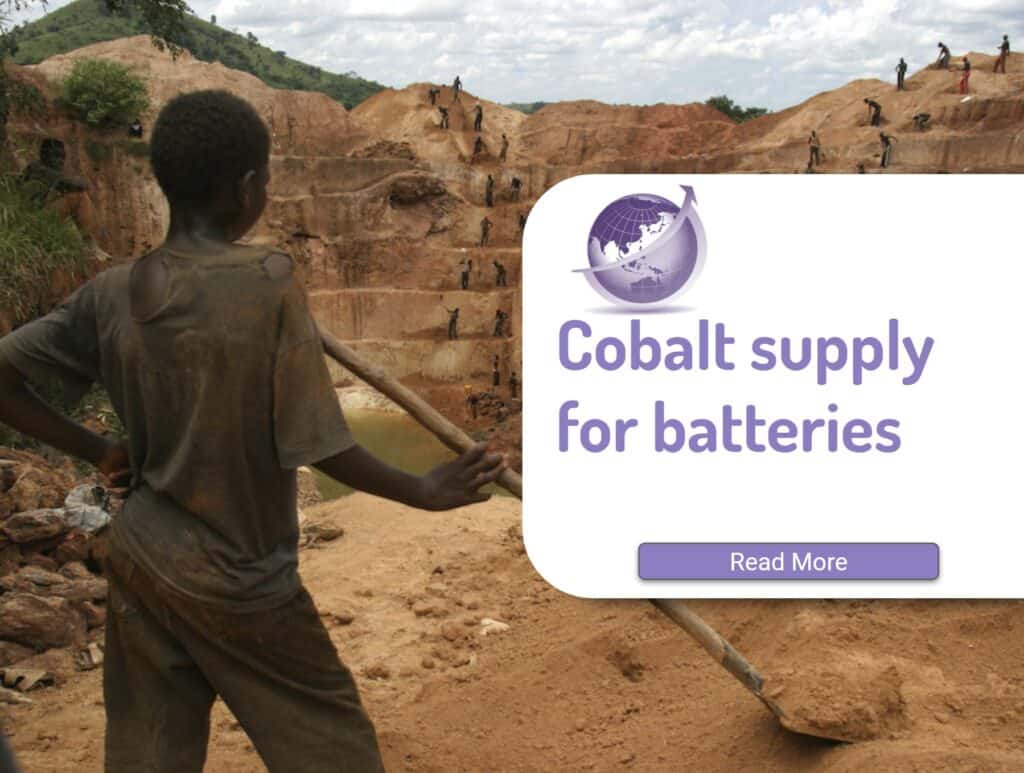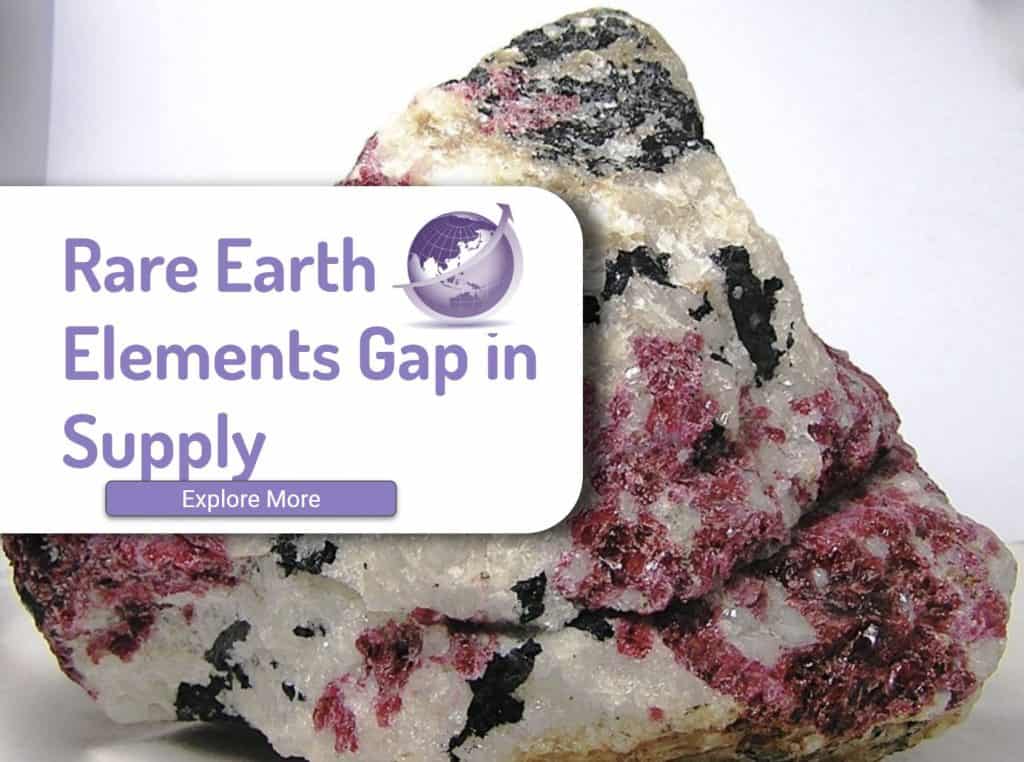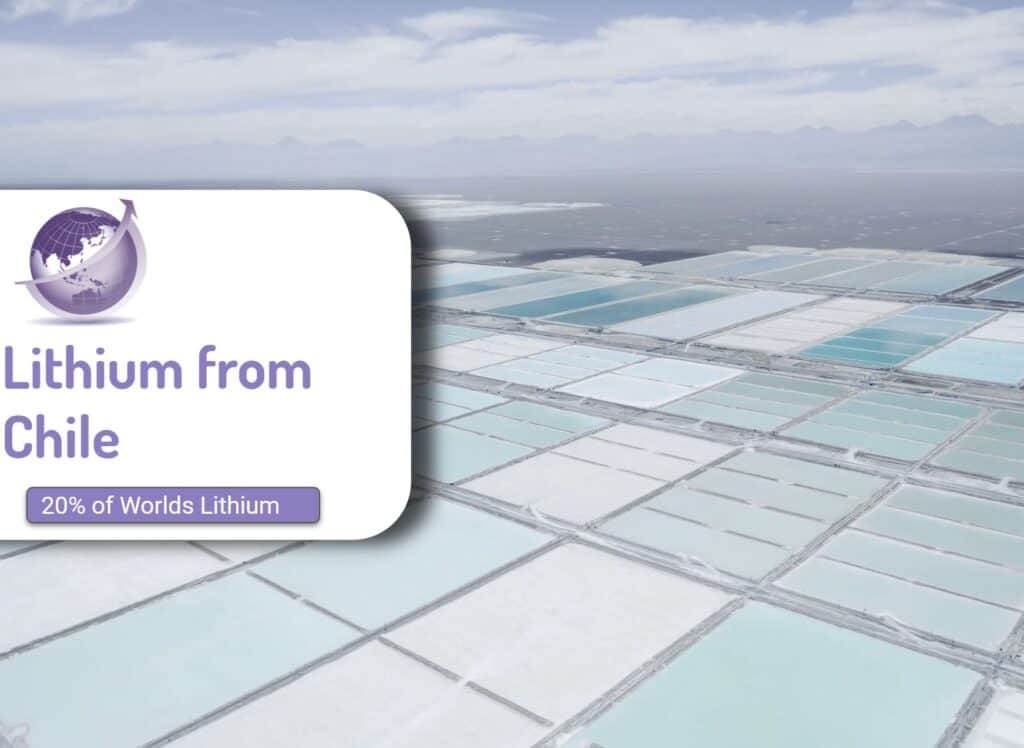Deep-sea mining is a proposed industry that aims to extract valuable minerals from the ocean floor. While it offers potential benefits for meeting the growing global demand for metals, it also poses significant environmental risks. The technology is not proven at commercial scale despite miners’ claims, the economics are dubious and subject to mineral demand and pricing. It is a contentious issue, and caught up in political machinations.
What Is Valuable In Deep-Sea Mining
There are only about 5 minerals in the deep-sea. Manganese, iron, nickel, cobalt and copper and as you will be aware, all of these are mined on land. So how do these minerals form and where are they in the deep-sea.
- Undersea Mineralisation: There are three primary types of undersea mineralisation of interest for mining:
- Manganese-rich crusts: Found in shallower waters.
- Sulphide deposits: Occur around “black smokers” (hydrothermal vents) and contain valuable metals like nickel, cobalt, and copper.
- Polymetallic nodules: Potato-sized lumps formed over millions of years by metals precipitating out of seawater. They are widely distributed on the deep ocean floor.
- Polymetallic Nodules:
- They are desirable because they don’t require intensive technologies like blasting rock.
- Their primary elements are manganese and iron, with smaller but more valuable amounts of nickel, cobalt, and copper.
- These deposits are not straightforward to process, as every mineral deposit is unique and requires a different method.
- Despite being investigated for over 50 years, they have not yet been extracted commercially.
Deep-Sea Minerals Mining Pros
- Access to Critical Minerals: The deep sea contains vast deposits of minerals essential for modern technology, including cobalt, nickel, manganese, and copper. These are vital components for electric vehicle batteries, renewable energy technologies, and electronics.
- Reduced Reliance on Terrestrial Mining: Deep-sea mining could decrease the need for land-based mining, which is often associated with significant environmental damage, such as deforestation, soil and groundwater pollution, and habitat destruction. It also may reduce reliance on countries with a monopoly on certain minerals or those with poor human rights records in mining operations.
- Lower Environmental Footprint (in some respects): Proponents argue that deep-sea mining could have a lighter carbon footprint than conventional terrestrial mining.
Deep-Sea Mining Cons
- Irreversible Habitat Destruction: The deep-sea floor is home to unique and slow-growing ecosystems. The process of mining, which involves large-scale dredging and scraping, would permanently alter or destroy these habitats, including the metallic nodules that have taken millions of years to form and on which much of the biodiversity lives. Scientific monitoring of experimental dredge sites in deep-sea sediment has shown that decades after a site is disturbed, few if any communities of organisms have recovered.
- Biodiversity Loss: Many deep-sea species are rare, long-lived, and slow to reproduce. The direct removal of their habitat could lead to the extinction of species that are yet to be discovered or studied.
- Sediment Plumes and Pollution: Mining activities stir up fine sediments, creating plumes of suspended particles. These plumes can travel for miles, potentially smothering marine life, damaging feeding and respiratory structures of organisms, and introducing pollutants into the water column.
- Noise and Light Pollution: Deep-sea environments are naturally dark and silent. The noise and light from mining operations could disrupt the feeding, communication, and reproduction of a wide range of marine animals, including large megafauna like whales.
- Impact on Fisheries and Ecosystems: The disruption of deep-sea ecosystems could have cascading effects on global fisheries by damaging habitats that support commercial fish populations, affecting food security and the livelihoods of coastal communities.
- Uncertainty and Lack of Regulation: The full environmental impacts of deep-sea mining are not yet fully understood due to the unexplored nature of the deep ocean. The current regulatory framework for deep-sea mining in international waters, managed by the International Seabed Authority (ISA), is still in development and lacks consensus.
Clarion-Clipperton Zone
The CCZ is a vast abyssal plain located in the central eastern Pacific Ocean between Mexico and Hawaii. It’s one of the most promising areas for deep-sea mining due to the high concentration of polymetallic nodules, which are rich in valuable metals like manganese, nickel, copper, and cobalt. These metals are crucial for “green technologies” such as electric vehicle batteries and renewable energy infrastructure. The CCZ, however, is not a barren wasteland. It’s a unique and diverse ecosystem with a high percentage of endemic species, many of which have yet to be discovered and formally described.
The ISA has awarded 16 exploration contracts to state sponsors and contractors, allowing them to assess mining opportunities within the CCZ. Mining the nodules would involve scraping off the top layer of the ocean floor, separating the nodules from the mud, using a giant tube to pump them to a surface ship, and returning the water and fine particles through another tube. Many marine scientists are concerned about the potential impacts of disturbing the seabed in this manner. Nodules form over millions of years and cannot be replaced in any meaningful way. And scientists are just beginning to study some of the array of species that live at these depths, from sponges and sea anemones to shrimps and octopods. Little is known acted, and what damage may be caused by the spread of sediment plumes and other effects of mining as discussed previously.
A broad consensus is emerging among scientists that the ISA should prohibit seabed mining in at least one-third of the Clarion-Clipperton Zone and put stringent rules in place where mining is permitted.
Ore Grades and Mineral Value of Deep-Sea Mining
Assessing the value of the minerals is complex and depends on the following factors.
- Mineral Composition:
- Manganese: The principal metal (20–30%) used in steelmaking; it’s a large market.
- Iron: Also abundant (5–15%), but has a lower value.
- Copper: A large market, mainly used for wiring; deposits often contain about 1% copper.
- Nickel: About twice as valuable as copper, used in stainless steel and high-energy batteries; deposits can have around 1% nickel.
- Cobalt: The most valuable of the group, used in batteries and specialized alloys; it’s a byproduct of nickel or copper mining and makes up a small percentage of deposits (0.1–0.2%).
- Ore Grade Significance:
- Grades of 1% for copper and nickel, or 0.1–0.2% for cobalt, are considered very high grade by modern mining standards.
- Terrestrial mines today often operate on ores with lower grades (e.g., 0.75% copper or below 1% nickel).
- Grades have generally declined over time as the highest-quality deposits are mined first.
- Cobalt is rarely mined on its own and is typically recovered as a byproduct.
Deep-Sea Mining Challenges
Mining brings its particular challenges. All mining to date has been pilot, and no one has full production at depth.
- Depth and Pressure:
- Seabed mining targets are located in the abyssal plain, at depths of 4 kilometres or more.
- This is far deeper than typical offshore operations, such as offshore oil drilling (1.5 km) or offshore wind (50 meters).
- The immense pressure at these depths (400 times greater than at 10 meters) makes industrial operations extremely challenging and expensive.
- Location and Logistics:
- The primary area of interest is the Clarion-Clipperton Zone, located thousands of kilometers from shore.
- The remote location makes logistics and maintenance of equipment very difficult and time-consuming.
- High Costs:
- The rule of thumb is that capital costs increase dramatically with depth: 1x onshore, 10x on a platform, 100x underwater, and 1000x on the ocean floor.
- Moving parts in seawater face challenges like fouling and are very expensive to maintain.
Mineral Availability and Economics
The major factor about mineral availability is the price of the mineral commodity.
- Resources vs. Reserves:
- Resources are what is known to be in the ground.
- Reserves are the subset of resources that are technically and economically viable to extract at a given time and price.
- There is no shortage of resources; the key issue is whether they can be developed in a timely and economic fashion.
- Factors Influencing Mineral Availability:
- Price: Higher prices for metals like nickel or copper can make previously uneconomic deposits (resources) profitable to mine (reserves).
- Substitutability: Many metals have substitutes. For example, aluminum can substitute for copper in some wiring, and battery chemistries can shift away from nickel and cobalt (e.g., LFP batteries).
- Timeliness: The pace of the energy transition may outpace the rate at which new mines can be developed.
- Government and Company Decisions: Countries must approve projects, and companies must decide to fund them.
Recycling and the Circular Economy
Another driver in the supply chain is recycling. It is critically important in the steel industry, as scrap steel enables electric arc furnaces to process iron ore, whereas pure iron ore needs to be processed in blast furnaces. The demand for a mineral is balanced by supply of existing metal from recycling, and new minerals.
Recyclability of Metals:
- Many metals, like those in stainless steel, are infinitely recyclable.
- The challenge is the long service life of many products (e.g., 50–100 years for stainless steel, up to 20 years for EV batteries), which delays their return to the recycling stream.
- Current State of Recycling:
- Battery recycling can achieve recovery rates of 95–97% for critical metals.
- Recycling currently only meets a fraction of global demand because the world is in a stock-building phase, deploying more and more new devices. The best estimateis world needs about 300 TWh of batteries – not likely until mid-2040s.
- As demand plateaus in the future, recycling will become a much more significant source of supply, displacing the need for conventional mining.
- Future Recycling Opportunities:
- A massive potential source of recyclable metals is the infrastructure of the fossil fuel industry, such as pipelines, refineries, and supertankers.
- The dismantling of this infrastructure could provide a significant amount of high-grade scrap metal for recycling.

Deep Sea Mining Projects
The deep-sea mining industry is still in its exploration and research phases, with no large-scale commercial extraction yet underway.
| Company/Entity | Location (Exploration Area) | Status of Project | Target Minerals |
|---|---|---|---|
| The Metals Company (TMC) | Clarion-Clipperton Zone (CCZ), Pacific Ocean | Exploration, development, and environmental impact studies. Has conducted pilot nodule collection tests. | Polymetallic nodules containing Nickel, Cobalt, Manganese, Copper |
| Global Sea Mineral Resources (GSR) | Clarion-Clipperton Zone (CCZ), Pacific Ocean | Exploration and technology development. Has conducted collector vehicle tests. | Polymetallic nodules containing Nickel, Cobalt, Manganese, Copper |
| China Ocean Mineral Resources Research and Development Association (COMRA) | Clarion-Clipperton Zone (CCZ), Pacific Ocean; Southwest Indian Ocean Ridge | Exploration and research, with significant government funding for technology development. | Polymetallic nodules, Seafloor Massive Sulphides (SMS), Cobalt-rich Crusts |
| Deep Ocean Resources Development Co., Ltd. (DORD) | Pacific and Indian Oceans | Exploration and technological collaboration. | Cobalt, Rare Earth Elements |
| Nautilus Minerals | Bismarck Sea, Papua New Guinea | Formerly a key player with the “Solwara 1” project, but the company went bankrupt. Its project aimed to mine Seafloor Massive Sulphides. | Copper, Gold, Silver |
| UK Seabed Resources (a Lockheed Martin subsidiary) | Clarion-Clipperton Zone (CCZ), Pacific Ocean | Exploration contract with the ISA. | Polymetallic nodules |
| Loke Marine Minerals | Norwegian Exclusive Economic Zone (EEZ) and CCZ | Exploration and licensing, with a focus on both national and international waters. | Polymetallic nodules |
| Ocean Minerals LLC | Penrhyn Basin, Pacific Ocean (within Cook Islands’ EEZ) | Exploration and research. | Rare Earth Elements, Scandium |
| Bundesanstalt für Geowissenschaften und Rohstoffe (BGR) | Clarion-Clipperton Zone (CCZ) and Mid-Indian Ocean Ridge | Exploration as a government-backed entity. | Polymetallic nodules, Seafloor Massive Sulphides (SMS) |
Further Reading
- C.L. Van Dover et al., “Biodiversity Loss From Deep-Sea Mining,” Nature Geoscience 10 (2017): 464–65, http://www.nature.com/ngeo/ journal/v10/n7/full/ngeo2983.html.
- Daniel O.B. Jones et al., “Biological Responses to Disturbance From Simulated Deep-Sea Polymetallic Nodule Mining,” PloS ONE 12, no. 2 (2017): e0171750, https://doi.org/10.1371/journal.pone.0171750;
- Dmitry M. Miljutin et al., “Deep-Sea Nematode Assemblage Has Not Recovered 26 Years After Experimental Mining of Polymetallic Nodules (Clarion-Clipperton Fracture Zone, Tropical Eastern Pacific),” Deep Sea Research, Part I, Oceanographic Research Papers 58, no. 8 (2011): 885–97, http://archimer.ifremer.fr/doc/00047/15867/13321.pdf.
- International Seabed Authority, Legal and Technical Commission, “Environmental Management Plan for the Clarion-Clipperton Zone” (July 13, 2011), https://www.isa.org.jm/sites/default/files/files/documents/isba-17ltc-7_0.pdf.
- Ben Guarino, “Meet the Charming ‘Ghost Octopods’ Found Among Valuable Metallic Balls on the Deep Sea Floor,” The Washington Post, Dec. 20, 2016, https://www.washingtonpost.com/news/morning-mix/wp/2016/12/20/meet-the-charming-ghost-octopods-foundliving-among-valuable-metallic-balls-on-the-deep-sea-floor/?utm_term=.8b520c87ac10.
- T. Kuhn et al., “Chapter 2: Composition, Formation, and Occurrence of Polymetallic Nodules,” in Deep Sea Mining Resource Potential, Technical and Environmental Considerations, ed. Rahul Sharma (New York: Springer International Publishing, 2017), 52.
- Managing Impacts of Deep Sea Resource Exploitation, “Biodiversity in the Clarion-Clipperton Zone,” http://eu-midas.net/sites/default/ files/downloads/Briefs/MIDAS_CCZ_biodiversity_brief_lowres.pdf.
- Diva J. Amon et al., “Insights Into the Abundance and Diversity of Abyssal Megafauna in a Polymetallic-Nodule Region in the Eastern Clarion-Clipperton Zone,” Scientific Reports 6 (2016): 30492, https://www.nature.com/articles/srep30492.
- Elaine Baker and Yannick Beaudoin, eds., “Deep Sea Minerals: Manganese Nodules, a Physical, Biological, Environmental, and Technical Review,” Secretariat of the Pacific Community (2013), 36, http://dsm.gsd.spc.int/public/files/meetings/TrainingWorkshop4/ UNEP_vol1B.pdf
- From Clarion-Clipperton to Clean Tech: The Debate Over Seabed Mineral M Barnard Sep 2025 https://cleantechnica.com/2025/09/11/from-clarion-clipperton-to-clean-tech-the-debate-over-seabed-mineral/









